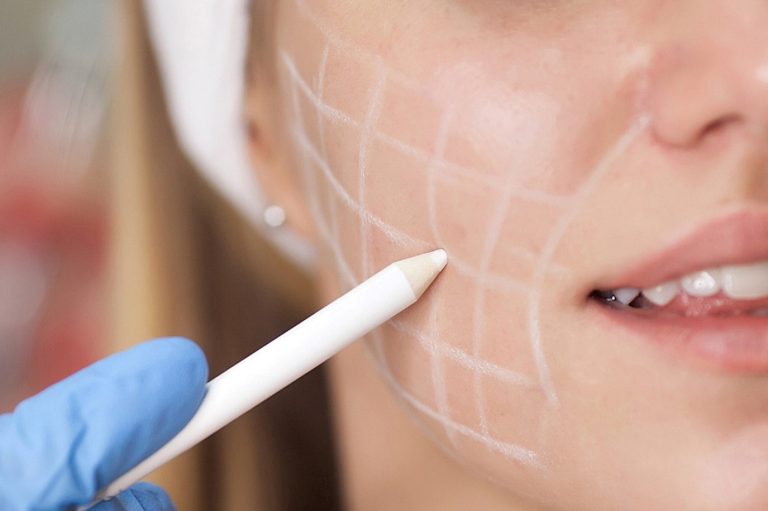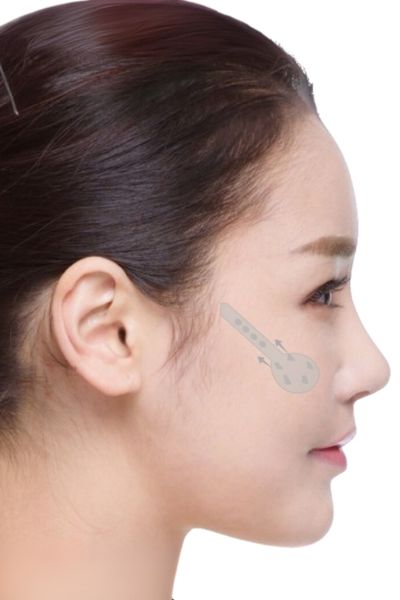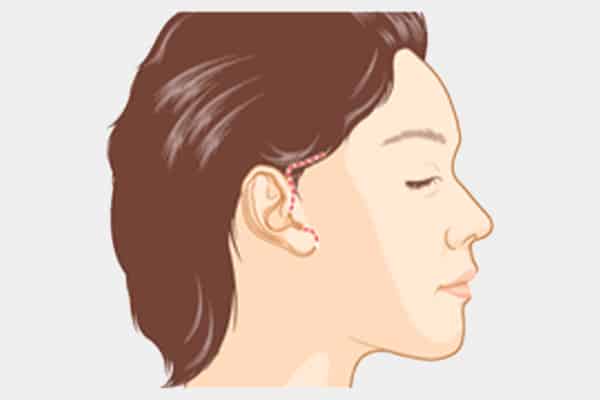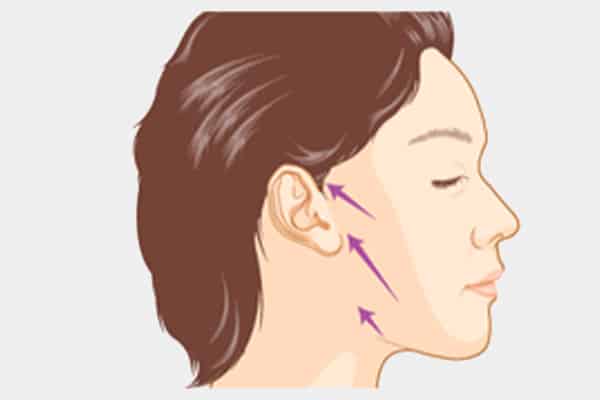
Facelift Surgery

Procedure Time
3 – 4 Hours

Anaesthesia
General Anaesthesia

Recovery Period
14 – 18 Days

Stitch Removal
7 Days Post-op
What is Facelift Surgery?

Facelift surgery, also known as a rhytidectomy, is a specialised cosmetic procedure aimed at addressing visible signs of ageing by repositioning facial tissues and tightening loose skin. This procedure helps improve facial contours and skin texture, targeting areas affected by sagging, wrinkles, and volume loss. The goal of the surgery is not to alter one’s natural features but to enhance and restore them to a more refreshed and youthful appearance.
How Ageing Affects the Face
As we age, facial tissues lose elasticity and volume, leading to sagging skin, deeper wrinkles, and hollowed cheeks. The skin’s natural support structure, including the SMAS (superficial musculoaponeurotic system) layer and facial ligaments, stretches and weakens over time. This process results in:
- Drooping cheeks
- Formation of deep nasolabial folds
- Development of jowls or a double chin
- Loss of youthful facial contours
Environmental factors, such as sun exposure, dehydration, and certain lifestyle habits, can accelerate these changes, causing fine lines to deepen into prominent wrinkles over time.
Facelift surgery is tailored to unique anatomical characteristics and ageing concerns. The procedure involves:
- Tightening the SMAS layer and underlying facial muscles for structural support
- Removing excess skin to create a smooth, firm appearance
- Repositioning facial tissues to restore youthful contours
For those with thicker skin and denser facial tissues, such as Asian features, achieving balanced and natural results requires meticulous surgical techniques to account for the weight and volume of the tissues.

Who Needs Facelift Surgery?
Facelift surgery may be suitable for those who experience:
- Pronounced wrinkles or deep facial creases.
- Sagging skin along the cheeks, chin and jawline.
- Limited improvement from non-surgical treatments or other lifting procedures.
- A preference for comprehensive and long-lasting facial rejuvenation.
Our approach ensures customised treatment plans tailored to the patient’s anatomy and aesthetic goals.
Facelift Treatment Sites

Types of Facelift Procedures Available
In Singapore, there are three types of facelift procedures available today. These include:

1. Endotine Facelift
The Endotine Facelift procedure involves the use of a dissolvable implant for effectively elevating and fixating soft tissue at specific points. The implant is affixed at various contact points. This technique is particularly useful for addressing wrinkles, sagging skin, and uneven tissue distribution, which can result in smoother and more balanced facial contours.
Endotine Facelift surgery is recommended for the treatment of mild-to-moderate skin laxity in areas such as the mid-face, neck, forehead, cheek, and jowls. It is especially effective in treating crepey skin textures caused by irregular fat distribution and reducing the appearance of nasolabial folds. Those undergoing this procedure typically experience bruising and swelling, which generally resolves within 7–10 days. Most daily activities can be resumed after approximately two weeks.
This approach provides a focused solution for improving specific areas, offering noticeable results without extensive downtime.
2. MACS Lift or Mini Facelift
The MACS (Minimal Access Cranial Suspension) facelift is a procedure tailored to those seeking to address early signs of ageing, particularly in the mid-face region. It is well-suited for:
- Mild jowling or mid-face sagging.
- Those who have undergone previous lifting procedures and desire more pronounced results.
This procedure involves strategically placed incisions that leave minimal, inconspicuous scarring, offering a refined approach to rejuvenation while maintaining a natural appearance.
Unlike other traditional procedures, mini facelift surgery uses a short-scar endoscopic facelift method to reposition underlying muscles and fat vertically, which helps restore youthful mid-face contours while minimising scarring. Depending on the patient’s needs, the procedure can be complemented with additional fat grafting to address volume loss in areas like the cheek and brow, achieving a more rejuvenated look.

Step 1
An incision is made along the hairline, allowing the surgeon to access the soft tissues around the mid-face area.

Step 2
Sutures are used to adjust the position of loose tissue and fat pads. These are then anchored securely to the deep temporal fascia for long-lasting support.

Step 3
The incision is closed with sutures, which remain concealed behind the hairline. Post-surgery, the cheek area appears rejuvenated and lifted, with improved contours.
Recovery involves a typical timeline of 10–14 days for swelling and bruising to subside, with patients able to resume most daily activities after about three weeks.
3. Traditional Facelift (Rhytidectomy)
The traditional facelift surgery is a comprehensive procedure aimed at addressing advanced signs of ageing, including severe skin laxity, deep wrinkles, and uneven subcutaneous tissue distribution. It is often recommended for those who have not achieved satisfactory results from less invasive procedures and are looking for more pronounced, long-lasting outcomes.
During the procedure, the surgeon makes incisions along the hairline and natural contours of the ears, extending behind the ear to the nape of the neck. This placement ensures the scars remain inconspicuous. The technique involves repositioning both the superficial and deeper tissues, as well as removing excess skin, to achieve significant improvements in facial definition.

This approach addresses multiple ageing concerns in one procedure, including lifting sagging cheeks and brows, smoothing deep folds, and refining the jawline. Recovery typically requires about two weeks for initial swelling and bruising to subside. However, it is important to note that full healing, including the fading of scars, may take several months. Patients are advised to avoid vigorous activities during the early recovery phase to support optimal healing and minimise risks.
What Does Facelift Surgery Do?
Facelift surgery offers a targeted solution to address the visible signs of ageing, particularly in the face and neck. This specialised procedure aims to enhance natural contours, reduce sagging, and restore a smooth, revitalised appearance.
- Reduction of wrinkles and fine lines: By repositioning the skin and underlying tissues, a facelift minimises wrinkles and creases, particularly around the cheeks, jawline, and neck. This creates smoother skin surfaces.
- Enhanced facial contours: Adjusting sagging skin and deeper tissues restores definition to the jawline and lower face. This approach addresses volume loss and improves the overall symmetry of the face.
- Correction of sagging skin: By addressing loose skin, the procedure reduces the appearance of jowls and enhances skin tension, improving both function and form.
- Durable, longer-lasting results: Unlike non-surgical treatments, a facelift targets the root causes of ageing, offering results that generally persist for several years, depending on factors such as skin quality and lifestyle habits.
Combining Facelift Surgery With Lasers Or Injectables
Recovery From Facelift Surgery
Recovering from a facelift surgery is a progressive journey that varies from person to person. While the initial recovery involves managing swelling and bruising, full healing and results take time. Here is a typical recovery timeline:
- 1–3 Weeks: Most swelling and bruising significantly subside. During this time, rest and following the surgeon’s care instructions are essential for optimal healing.
- 2–3 Weeks: Non-strenuous activities can typically be resumed, subject to medical clearance. Light social engagements may also become more comfortable as visible signs of recovery diminish.
- 6 Months and Beyond: Residual swelling gradually resolves, and scar maturation progresses, revealing the refined contours and full results of the procedure.
Proper post-operative care, including regular follow-up consultations, ensures a smoother recovery. These sessions allow the surgeon to monitor progress, address any concerns, and provide tailored advice on resuming specific activities. Adhering to these guidelines supports a smoother recovery process and helps achieve the desired surgical outcome.
Frequently Asked Questions (FAQ) about Facelift Surgery in Singapore
What Is Considered The Ideal Age To Undergo A Facelift Procedure?
The facelift procedure depends on the condition of the facial skin rather than the age. Aging is a process that differs from one individual to another. The type of procedure is tailored to the patient’s unique set of facial features and skin type.
Older people (regardless of age) with good health can get to enjoy facial rejuvenation benefits via a facelift procedure. In the majority of the cases, no patients are rejected for treatment on the basis of old age.
Who Is An Ideal Candidate For Facelift?
The proper age for when a person should undergo a facelift varies from person to person. As the aging experiences of each person are different, a facelift procedure is customized to a patient’s unique facial characteristics. It ensures that a person can benefit from a facelift to achieve a balanced, natural-looking facial appearance.
The ideal candidate must:
- have good general health
- have excessive skin on the face and neck
Can A Facelift Make Me Look A Lot Younger?
A facelift procedure can “set the clocks back” for you. The aging signs (sagging, loose skin, weakened muscles, and diminished bone density) can subside to some extent but the procedure cannot stop the aging process. You can achieve a younger, fresher look but the change relies on the extent of skin damage that has already been done.
The environment casts its impact on your skin. Your skin texture and bone structure can be affected by environmental toxins, skin exposure, and smoking. Therefore, to keep your skin rejuvenated after the surgery you must take good care.
Will My Skin Look Stretched After The Surgery?
The way your skin looks postoperatively very much relies on the skills and technique used for the procedure. The modern facelift is no longer just a simple procedure of trimming the excess skin and closing the surgical cuts. Unlike old methods, today’s procedures impart multiple benefits and result in a more natural look:
- Tightening of underlying facial muscles
- Restoration of lost volume
- Removal of excess skin
The patients may be recommended to undergo neck lift surgery too. This is to avoid the disparity between facial and neck skin. In the neck lift procedure, sagging neck skin (aka turkey wattle) is restored to its tight and fresh form.
What Is The Anesthesia Of Choice?
The patient get to choose between two types of anesthesia:
- Local anesthesia with IV sedation
- General anesthesia
A pre-operative consultation is done by the surgeon with the patient and the pros and cons of all the options are discussed. The extent of work is the deciding factor for anesthesia selection.
The decision is also shadowed by the advice of a board-certified anesthesiologist.
How Long Does The Surgery Take?
On average a facelift procedure lasts for 3 hours or so. However, the duration of the surgical procedure varies from one individual to another and is dependent on these factors:
- The extent of the changes to be undertaken
- Type of technique used
For example, a mid-face lift procedure lasts for a couple of hours. When going for extensive surgical combinations such as facelift neck, neck lift + eye lift, the surgical procedure can take well over 5 hours.
Are The Facelift Scars Visible To Others?
The majority of incision lines given during surgery are hidden behind the hairline or in the natural creases. The scars from the operation are noticeable in the initial days of recovery. Several months after the procedure, scars start to fade and blend into the surrounding skin. They become less and less noticeable overtime.
Where possible, the plastic surgeon tried to avoid giving big incisions. So, a smaller incision is faster to heal and the scar is smaller too.
When Can I Start A Normal Life After Surgery?
All surgical procedures take time to heal. In order to carry out proper care for your facelifted skin, you should limit your activities for a few days initially. You can follow these instructions for better and quicker recovery:
- Do not do exercise for at least 2-3 weeks after surgery
- Keep your head elevated when resting
- Relax as much as you can in the 1st week of healing
- Gently wash your face (after dressing removal)
- Avoid sun exposure
You can return to normal life working by following these precautions. Usually, patients can resume work 2 to 3 weeks after the surgery.
How Much Time Is Required For Full Recovery?
The healing rates vary between patients and are greatly affected by the age of the patient. Young patients have a faster healing rate while older patients take longer. You can experience the following healing stages:
First 10 Days
This is the first stage of healing. In this stage, it is common to experience a rise in swelling which it typically peaks around the fourth day after the procedure. The swelling will start to subside gradually and continue to improve over the next week.
10 – 14 Days
The next stage lasts for a couple of weeks after the first stage. By this point, there is an evident improvement in the skin. Majority of the swelling and the bruising would have subsided, therefore, patients start to resume social interactions by this stage. The remnant swelling which will still result in slight puffiness will take a longer time to subside fully.
14 Days – 6 Months
The process of healing continues to proceed at a slow rate from 3 weeks to 6 months. In most cases, maximum results are achieved after 3 months (90%).
What Can I Expect?
You can discuss your issues with the surgeon who analyzes your skin tone, texture, and quality along with the extent of the issue. Based on the medical history, age, and facial features, the surgeon recommends the best treatment option.
Plastic surgeons give you a realistic approach towards the changes that can be brought about. The limitations to your (if any) will be discussed prior to the treatment to avoid any inconvenience later on. If you are a suitable candidate for the facelift the doctor will tell you so. Otherwise, he would recommend other procedures such as thread lift for your consideration.
How To Prepare For A Facelift?
Your surgeon may recommend the following before the surgery:
- Stop certain medications days prior to surgery (including blood thinners, and anti-inflammatory drugs, etc.)
- Stop taking any herbal supplements
- Avoid smoking
These precautions allow for a better chance of quicker healing and minimize surgical risk.
